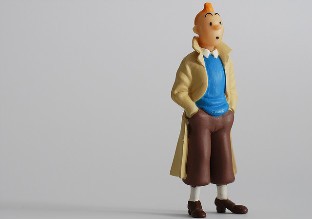Saved by Tintin

From where I sit at the family dinner table my eyes fall on a tall bookcase, on top of which, just under a map of Narnia, a crowd of small resin figures seems to be in perpetual motion. One of them, the diva Bianca Castafiore, is singing the "Jewel" aria from Gounod's Faust, but if she is not run over by two detectives in bowler hats driving a green 1926 Citroën 5HP, she will soon be knocked down by Professor Calculus walking in an intellectual trance, or by Captain Haddock pacing the deck. Interspersed among these characters, smaller than the rest, yet the reason for their very existence, is Tintin, the young reporter, standing in his blue sweater and brown plus fours before a preternaturally large Amanita muscaria mushroom, scaling a craggy cliff in kilt and tam, trekking in a pith helmet and khaki shorts, crouching in a porcelain vase with his white terrier Snowy.
Down in the basement—but we've just carted them upstairs to get reacquainted—are the 23 original Tintin books we've collected over the past three decades. When we first discovered Tintin, while studying abroad in Paris, he was almost unknown in the U.S. We liked to think of him as our private enthusiasm. All that has changed: with the release of the Stephen Spielberg and Peter Jackson film, Tintin belongs to the world.
Read our latest issue or browse back issues.
The creator of Tintin, Georges Remi—whose initials, reversed, produced the pen name Hergé—was the brightest star of the Franco-Belgian school of cartoon illustration (bandes dessinées). Hergé pioneered what he called the ligne claire (clear line), strong black outlines without shading or crosshatching, illuminated like a book of hours by layers of flat, saturated color. Each object has a similar value, whether it is the wake of a ship, a line of prayer flags or a bottle of whiskey concealed in Captain Haddock's pocket. There is plenty of movement, but nothing hectic or extraneous. While disciples of Hergé have used the clear line method for ironic effect (Where's Waldo? is a good example), in Hergé's hands it suggests moral clarity. One has only to look at Tintin, his round face animated by the simplest imaginable features, to know that he is Pure Heart (as the high lama calls him in Tintin in Tibet), defender of the weak and downtrodden, loyal, resilient, ever youthful, endlessly cheerful and tolerant of the foibles of his eccentric friends, never cowed by evil—the ultimate Boy Scout.
One would like to think that Tintin's creator shared all these qualities. Artists don't have to be saints to be able to portray them, but they do need to have at least a spark of sainthood to get it right. Georges Remi's case, however, is complicated. He grew up in German-occupied Brussels, where home life was, he said, a "monochrome gray." He received his moral formation in the Belgian Catholic Boy Scouts and found his vocation as an artist under the tutelage of the Abbé Norbert Wallez, publisher of the Catholic journal Le Vingtième Siècle and advocate of a militant social Catholicism, anti-Bolshevist, anticapitalist, anti-Semitic and pro-colonialist.
More artist than thinker, Hergé tended to absorb the influences that surrounded him. The childlike natives in Tintin in the Congo and the hook-nosed Jewish financiers that crop up in Hergé's early efforts were all he knew then, he said later. As political currents shifted he tried to find neutral ground, but often misread the signs of the times.
Yet there is a more edifying story to be told. Tintin is consistently the defender of the oppressed. He socks the arrogant colonialist he finds harassing a rickshaw driver, rescues the human cargo of a slave trafficker's ship, defends gypsies and Indians and contends against gangsters and despots. When Hergé decided, in 1933, that his next Tintin adventure would take place in China—he felt a strong identification with the Chinese under occupation by Japan—he turned to three sympathetic Catholic priests for advice, and through one of them met Chang Chong-Chen, in Brussels on a fine arts scholarship. They became the best of friends. Chang taught Hergé Chinese calligraphy and philosophy and endlessly described the details of his life in Shanghai. "I discovered a new world," Hergé said, and with it a new resolve to base his portraits of other cultures on assiduous research. This new "documentalist" approach was, according to Claude Lévi-Strauss, a breakthrough in ethnography. Chang would also become a character in The Adventures of Tintin, and in many ways Tintin's dearest friend. In The Blue Lotus, the two friends, having instantly cured each other of xenophobia, dissolve in laughter over their former prejudices.
But Hergé remained a troubled soul. In the 1950s, as his first marriage was breaking up, he was frightened by nightmares involving "great white spaces." To resolve his guilt, he sent Tintin on the most metaphysical of his adventures—desperately searching amid the great white spaces, remote monasteries and yeti caves of Tibet for his lost friend Chang. For many years the real Chang was lost too; when they were reunited in 1981, Chang was recovering from imprisonment by the Red Guard, and Hergé was suffering from the disease that would claim him in 1983.
"I poured myself into Tintin," Hergé would often say; and whether or not this resolved his moral struggles, he gave the world a true hero, a company of madcap friends and a vision of sheer goodness as the greatest human adventure.






